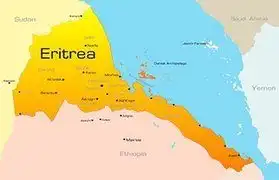Learn Tigrinya easily and fast
Learn Tigrinya fast and easily with our language course ‘Tigrinya for beginners’.
![em]() English (US]
»
English (US]
»
![ti.png]() ትግሪኛ
ትግሪኛ
| Learn Tigrinya - First words | ||
|---|---|---|
| Hi! | ሰላም! ሃለው | |
| Hello! | ከመይ ዊዕልኩም! | |
| How are you? | ከመይ ከ? | |
| Good bye! | ኣብ ክልኣይ ርክብና ( ድሓን ኩን]! | |
| See you soon! | ክሳብ ድሓር! | |
What is the best way to learn the Tigrinya language?
Learning the Tigrinya language connects one to a rich cultural heritage and history. Start with immersion by listening to Tigrinya music, watching films, and engaging with media. This foundational step acclimatizes you to the sounds and rhythms, easing the learning curve. Building a strong base in Tigrinya requires understanding its script and grammar. Online resources, tailored to beginners, offer structured lessons. These materials are invaluable for grasping the basics and progressively mastering more complex aspects.
Practicing with native speakers significantly enhances proficiency. Language exchange platforms facilitate this, allowing learners to converse, improve comprehension, and fine-tune pronunciation. Such real-world practice is irreplaceable for language acquisition. Incorporating Tigrinya into your daily routine accelerates learning. Label everyday items in your home with Tigrinya names and attempt to think in the language. This method ensures constant interaction, solidifying your learning experience.
Reading Tigrinya literature and newspapers expands vocabulary and offers insights into the culture. Starting with simple texts and gradually moving to more advanced materials improves understanding and fluency. This step is crucial for developing reading skills. Enrolling in formal Tigrinya courses provides a structured learning path. These programs often cover all language aspects, including writing, reading, speaking, and listening, and are designed for different levels of learners.
Using language learning apps that feature Tigrinya can supplement traditional learning methods. These apps often include interactive exercises that make learning fun and engaging, reinforcing vocabulary and grammatical structures. Reflecting on your progress is important for staying motivated and identifying improvement areas. Maintaining a journal in Tigrinya not only enhances writing skills but also serves as a personal record of your language journey, encouraging continual growth and adjustment.
Even Tigrinya beginners can learn Tigrinya efficiently with ‘50LANGUAGES’ through the practical sentences. First you will get to know the basic structures of the language. Sample dialogues help you to express yourself in the foreign language. Prior knowledge is not required.
Even advanced learners can repeat and consolidate what they have learned. You learn correct and frequently spoken sentences and you can use them immediately. You will be able to communicate in everyday situations. Use your lunch break or time in traffic to learn a few minutes of Tigrinya. You learn on the go as well as at home.
Learn for free...
Text book - English (USA) - Tigrinya for beginners Learn Tigrinya - First words
Learn Tigrinya with the Android and iPhone app ‘50LANGUAGES’
The Android or iPhone app ‘Learn 50 languages’ is ideal for all those who want to learn offline. The app is available for Android phones and tablets as well as iPhones and iPads. The apps include all 100 free lessons from the 50LANGUAGES Tigrinya curriculum. All tests and games are included in the app. The MP3 audio files by 50LANGUAGES are a part of our Tigrinya language course. Download all audios for free as MP3 files!








